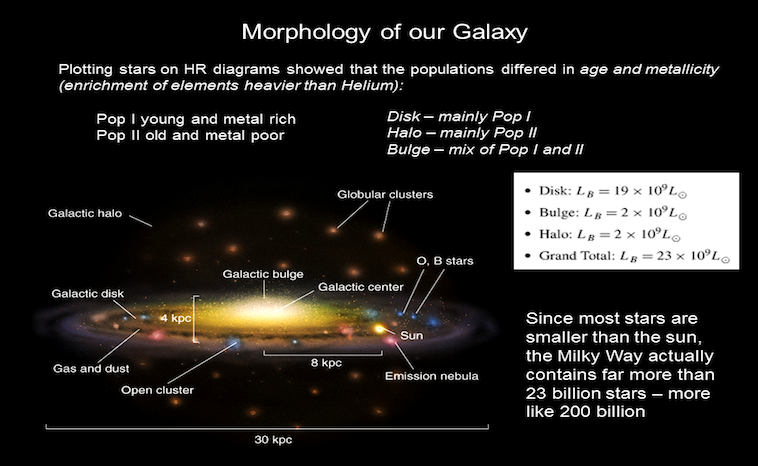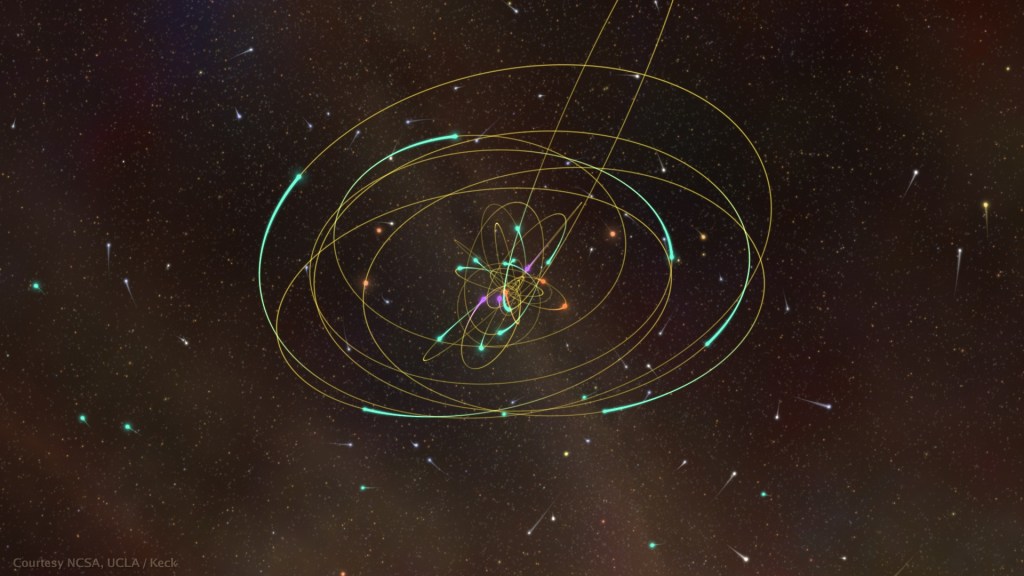
Over the course of my last eight posts, we’ve covered just about everything there is to cover about our home galaxy–or, well, at least the basics.
We’ve explored how astronomers first discovered what that incredible, milky stream of dust across the night sky actually is. We’ve followed astronomers like the Herschels and Harlow Shapley as they tried to measure the size of our galaxy.
We’ve covered its structure–a thin disk of spiral arms, surrounded by an enormous, diffuse halo–and how truly massive this great wheel is.
We then explored those spiral arms, where all the youngest stars are–and where stars form in the first place. And we explored the chaotic nucleus at the very center of the galaxy.
Most recently, we delved into the composition of the Milky Way–that is, how much heavy elements its stars contain. We discovered that stellar compositions hint at how old certain parts of the galaxy are.
But there’s one question we haven’t answered yet, and it’s quite possibly the most important one of all.
How did the Milky Way actually become what it is today?
The answers are written in its stars. But those answers weren’t easy to find.
Let’s start by taking a look at the relative abundances of elements in the universe. (That’s science speak for how much there is of stuff compared to how much there is of other stuff.)

In my last post, we discovered that stars in the galaxy’s nucleus and halo are very low in heavy elements. We also discovered that this means they are old stars.
Remember that elements heavier than helium are created via nucleosynthesis, a process of fusing atomic nuclei together to create heavier nuclei.
Fusing atomic nuclei together to create heavier nuclei is literally how stars fuel themselves, burning bright for millions to billions of years. So, by nature, they’re experts at nucleosynthesis.
The first generations of stars would have formed from gas clouds that didn’t have much of the heavy elements. They were the first, after all. But each subsequent generation of stars would have formed from clouds that were richer and richer in heavy elements.

Thanks to stellar spectra, astronomers can measure how much of each element there is in a star’s atmosphere. Spectra are basically the closest we get to taking home test tubes from the stars. A spectrograph allows us to sample stars’ atmospheres from afar.
Anyway. As we discussed in my last post, the star’s core will have changed due to nucleosynthesis, because that’s where the nuclear fusion reactions are. But the atmosphere doesn’t change. Stars’ atmospheres are relics from when they first formed–and, lucky for us, that’s exactly what a spectrograph looks at.
The amount of heavy elements in a star’s atmosphere tells us if it’s from an older or younger generation of stars, before or after the interstellar clouds of its birth were enriched by nucleosynthesis.
Now, let’s take a look at the structure of our galaxy. (This graphic also summarizes everything you need to know about stellar compositions for this post.)

Based on the composition of the stars in our galaxy, we know that its disk component is very young, and the spiral arms within are even younger. The spherical component–the central bulge and the halo combined–is old.
But why?
In the 1950s, astronomers didn’t have as much evidence to work with as they do today. Observations of stars and star clusters in our galaxy weren’t as detailed and clear.
So, with the limited data available, they came up with a hypothesis: the monolithic collapse hypothesis, also known as the top-down hypothesis.
Keep in mind, as you read this, that this is an early hypothesis. It doesn’t explain all the evidence we have today. But all scientific hypotheses start somewhere. This is an example of how astronomers modify their hypotheses to fit new evidence.

The monolithic collapse hypothesis suggests that, more than 13 billion years ago, the galaxy formed from a single large protogalaxy cloud. This cloud would have been full of turbulent, metal-poor gas.
Gravity would have pulled the gas inward, similar to how the gravitational center of a giant molecular cloud collapses to form a newborn star.
Turbulence within the cloud would make the collapse a messy process. Instead of just collapsing all at once, smaller clouds would fragment from one another and orbit the center at random velocities.
These individual clouds would form stars and star clusters–each with very different orbits. Some orbits would be mostly circular, but most orbits would be highly eccentric–that is, elliptical. (Basically an oval.)

But those orbits can’t stay chaotic and random forever. Soon, the clouds collide, eventually canceling out their random velocities. The protogalaxy cloud develops an even, uniform rotation.
A collapsing cloud must conserve angular momentum. You see this when a spinning ice skater draws their arms inward to spin faster. If you move your mass toward your center, you spin faster–and vice versa.
So as a cloud collapses, it must spin faster.
Now, imagine if you held, say, a yo-yo, and started spinning around.

As you spin, the yo-yo is thrown out. The string spins around you like a helicopter blade. The faster you spin, the more taut the yo-yo string becomes. In reality, the string is limp and noodley, but it seems as if it’s as stiff as that helicopter blade!
That’s essentially how a contracting cloud works.
As the protogalaxy cloud contracts and spins faster, its equator is thrown out like your yo-yo. And the faster it spins, the flatter the cloud becomes.

This flattening would have taken billions of years. At the start, stars would have been forming all throughout the cloud. As it flattened, stars and star clusters that formed in the outer reaches of the cloud would have been left behind.
The contracting cloud would continue to form new stars, and those closest to the equator–the center of collapse–would be the youngest.
See where I’m going with this?
That’s how you get a spiral galaxy with a profile like this one.

Well…sort of.
Remember how I said this is an incomplete hypothesis, based on the data available in the 1950s?
There’s one major problem with the monolithic collapse hypothesis. If the entire galaxy formed from one protogalaxy cloud, then all the stars in the halo–the stars that were “left behind” as the cloud contracted–should be roughly the same age.
But they’re not.
Globular clusters–the tightly-bound, spherical star clusters found mostly in the halo–actually have a wide range of ages. Even weirder, some of the youngest globular clusters are in the outermost reaches of the halo!
Clearly, the monolithic collapse hypothesis doesn’t quite fit the evidence…so astronomers needed to modify it.
The bottom-up hypothesis may just solve the problem.

There might, indeed, have been an original “monolithic collapse” that formed the spherical component (the central bulge and halo).
If those parts of the galaxy formed first, from a single collapsing cloud, it would explain why they are–as a whole–older than the disk component.
But the bottom-up hypothesis suggests that after the halo formed and collapsed to form the central bulge, new material enriched the galaxy.
Intergalactic clouds like those in the graphic above would have fallen in towards the Milky Way and interacted with the forming galaxy. They would have settled into orbits around the galactic center, eventually merging to form the disk.
And that’s not all.

Small “dwarf galaxies” would also have been caught in the Milky Way’s growing gravitational pull–like the Sagittarius dwarf galaxy.
The Sagittarius dwarf galaxy no longer exists, at least not as a galaxy. It’s mostly been pulled apart and devoured. But we can still see the evidence of its interaction with our galaxy. The remains of the galaxy’s center are a dense star cloud trailed by streamers of stars and dust.
These streamers are made up of material that was left behind as the galaxy gradually fell into the Milky Way’s disk. Each pass through the disk would have stripped it of its material.

Here is a “big picture” of the Milky Way, in all its glory.
On the bottom left of the spiral, you can see the Sagittarius star stream. That, people, is galaxy formation in action. When we look at that star stream, we are literally watching our galaxy being built even in the present day. It continues to absorb smaller galaxies and clouds.
In fact…see those two intact dwarf galaxies, far to the bottom left?
Those are the Large Magellanic Cloud and Small Magellanic Cloud. My southern-hemisphere readers might know exactly what I’m talking about–they’re visible only in the southern sky. I’ve actually never seen them before.
The Sagittarius dwarf galaxy might well have looked a lot like those magellanic clouds, once upon a time.
And, millions of years into the future, the magellanic clouds–which are currently intact galaxies–might just go the way of the Sagittarius dwarf.
One day, they may be gobbled up too, visible only as a magellanic star stream in Earth’s southern skies.
This bottom-up hypothesis explains most of the evidence. If the Milky Way was primarily assembled from smaller, separate parts–gas clouds and dwarf galaxies building the Milky Way’s disk–that would explain why the disk component is so much younger than the spherical component.
There are also…ahem…quite a few dwarf galaxies that could be up for grabs.

The bottom-up hypothesis would also explain why there are young objects in the outer reaches of the halo. The new material has to enter the galaxy somewhere. It would start out in the halo and then drift through into closer orbit.
There are still problems with the bottom-up hypothesis–but that’s why astronomers keep making observations and doing research. There’s always more to learn, and galaxies are truly at the forefront of human knowledge.
Anyway, we’ve now finished our exploration of our galaxy. Before we move on to the vast universe of galaxies, we’ll take a step back with an overview post to tie all the aspects of the Milky Way together.

